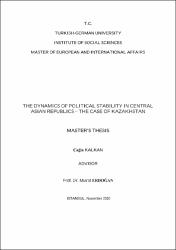| dc.contributor.author | Kalkan, Çağla | |
| dc.contributor.author | Erdoğan, Murat | |
| dc.date.accessioned | 2021-01-28T07:27:16Z | |
| dc.date.available | 2021-01-28T07:27:16Z | |
| dc.date.issued | 2020 | en_US |
| dc.date.submitted | 2020 | |
| dc.identifier.citation | Kalkan, Çağla (2020). The dynamics of politıcal stability in central asian republics - the case of Kazakhstan. Türk-Alman Üniversitesi, Sosyal Bilimler Enstitüsü, İstanbul. | en_US |
| dc.identifier.uri | https://hdl.handle.net/20.500.12846/492 | |
| dc.description.abstract | Bu yüksek lisans tezi Orta Asya’daki siyasi istikrarın sağlanması ve korunması için bölgenin kendine özgü dinamiklerini bulmaya çalışmıştır. Bu konuda bölgede boyların ve siyasi otoritenin dengeyi koruması için gerekli olan şartlar irdelenmiştir. Kazakistan’daki boyların yıllar içindeki değişimi ve nasıl Sovyet sistemine ayak uydurdukları anlatılmıştır. Günümüz Kazakistan’ındaki politik hayat ile aşiret ilişkileri incelenmiştir. Uzun zaman görev yapan Nazarbayev’in aşiretler arasındaki dengeyi kurmak için izlediği siyasi metotlar sıralanmıştır. Nazarbayev’in otoritesini en çok sarsan olaylardan biri olan Zhanaozen protestoları örnek olay olarak seçilmiştir. Vadim Volovoj’un “Sosyo-politik Ortaklık Yönetimi” argümanı Kazakistan’daki 2011 yılındaki Zhanaozen ayaklanması ile denenmiştir. Bu olayda boylar ve politik otorite arasındaki çıkar çatışması kanıtlanıp, sosyo-ekonomik düzey kontrol edilmiştir. Olaylar öncesi beş yıl içinde sosyo ekonomik düzeyde herhangi bir kötüleşme tespit edilememiştir. Sosyo-ekonomik düzeyin aşiret boyları ve politik otorite arasındaki çatışma sırasında önemli bir dinamik olduğu örnek olay incelemesi ile vurgulanmıştır. Çalışmanın sonucunda Zhanaozen olayının Volovoj’un argümanını destekler nitelikte olduğunu sonucuna varılmıştır. | en_US |
| dc.description.abstract | This master thesis tried to find the unique dynamics of the region in order to ensure and maintain political stability in Central Asia. In this regard, the conditions necessary for the clans and the political authority to maintain balance in the region have been examined. The change of the clans in Kazakhstan over the years and how they kept up with the Soviet system are explained. The political life and clans’ relations in Kazakhstan have been examined. The political methods followed by Nazarbayev, who served for a long time, to establish the balance between the clans are listed. The protests of Zhanaozen, one of the events that shook the authority of Nazarbayev the most, were chosen as a case study. The "Socio-political corporatism" argument of Vadim Volovoj was tested by the 2011 Zhanaozen uprising in Kazakhstan. In this event, the conflict of interest between the clans and the political authority was proved and the socio-economic level was controlled. No deterioration in the socioeconomic level was detected within five years before the events. It is emphasized by a case study that the socio-economic level is an important dynamic during the conflict between clans and political authority. As a result of the study, it was concluded that the Zhanaozen protests were supportive of Volovoj's argument. | en_US |
| dc.language.iso | eng | en_US |
| dc.publisher | Türk-Alman Üniversitesi, Sosyal Bilimler Enstitüsü | en_US |
| dc.rights | info:eu-repo/semantics/openAccess | en_US |
| dc.subject | Clans | en_US |
| dc.subject | Political Stability | en_US |
| dc.subject | Central Asia | en_US |
| dc.subject | Zhanaozen | en_US |
| dc.subject | Aşiret | en_US |
| dc.subject | Siyasi İstikrar | en_US |
| dc.subject | Kazakistan | en_US |
| dc.title | The dynamics of politıcal stability in central asian republics – the case of Kazakhstan | en_US |
| dc.type | masterThesis | en_US |
| dc.relation.publicationcategory | Tez | en_US |
| dc.contributor.department | TAÜ, Sosyal Bilimler Enstitüsü, Avrupa ve Uluslararası İlişkiler Ana Bilim Dalı Koleksiyonu | en_US |

















